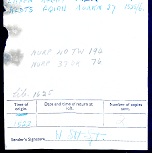 Code-breaking experts at GCHQ are said to be 'satisfied' that the pigeon-borne message assumed to have been sent during World War Two cannot be decoded without access to the original cryptographic material.
Code-breaking experts at GCHQ are said to be 'satisfied' that the pigeon-borne message assumed to have been sent during World War Two cannot be decoded without access to the original cryptographic material.
They were set an intriguing challenge following the discovery of a pigeon's skeleton in the chimney of a house in Bletchingley, Surrey. The message – hand-written on a small sheet of paper headed Pigeon Service – was found in a small red canister still attached to the pigeon's leg bone.
During the war, the methods used to encode messages naturally needed to be as secure as possible and various methods were used. The senders would often have specialist codebooks in which each code group of four or five letters had a meaning relevant to a specific operation, allowing much information to be sent in a short message. For added security, the code groups could then themselves be encrypted using, for example, a one-time pad.
The message found at Bletchingley had 27 five-letter code groups, and the GCHQ experts believe its contents are consistent with that method, meaning that without access to the relevant codebooks and details of any additional encryption used, it will remain impossible to decrypt.
During World War Two some 250,000 pigeons were used by all arms of the services as well as the Special Operations Executive (SOE). They carried a wide variety of messages, flying the gauntlet of enemy hawk patrols and soldiers taking potshots at them to bring vital information back to Britain from mainland Europe.
Each pigeon in service was given an identity number. Two such numbers – NURP.40.TW.194 and NURP.37.OK.76 – have been identified on the Bletchingley message. Either of them could be the identity of the pigeon in the chimney. The curator of the Pigeon Museum at Bletchley Park is trying to trace these numbers, and if they are identified and their wartime service established, it could help to decode the message, as could identifying Sjt W Sto and X02.
A GCHQ spokesman said: "Although it is disappointing that we cannot yet read the message brought back by a brave carrier pigeon, it is a tribute to the skills of the wartime code-makers that, despite working under severe pressure, they devised a code that was undecipherable both then and now."